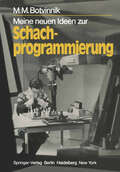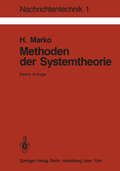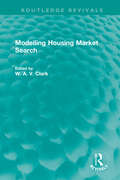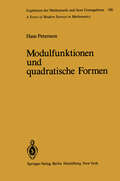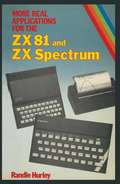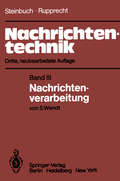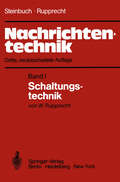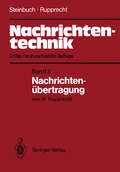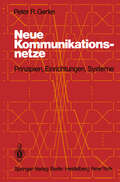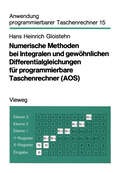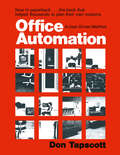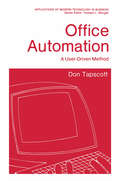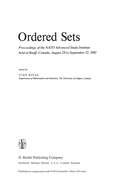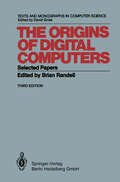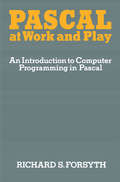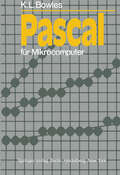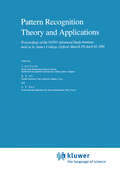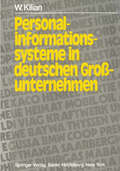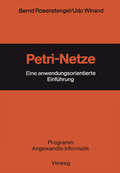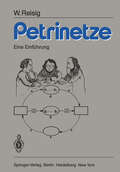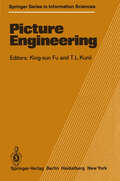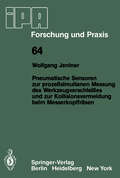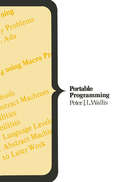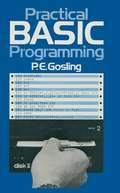- Table View
- List View
Meine neuen Ideen zur Schachprogrammierung (Informationstechnik und Datenverarbeitung)
by M. M. BotvinnikIn diesem Buch darf ich erstmals in deutscher Sprache umfassend und aktuell meine Ar beit an Grundlagen und Realisierung eines Computer-Schachprogramms vorstellen. Seit nunmehr gut zehn Jahren bemühen sich meine Mitarbeiter und ich um die Verfolgung eines anderen Ansatzes bei der Schachprogrammi erung als fast alle übri gen "Konkurrenten" der Wel t. Der intellektuelle Streit entzündet sich an der Fragestellung, ob vorrangig Schnellig keit, Speichergröße und Zuverlässigkeit von Rechnern auszunutzen seien, oder die Mo dellierung menschlicher Denkweisen beim Schachspielen angestrebt werden soll. Während die meisten Kollegen in aller Welt die erste Meinung vertreten und mit den nach der sogenannten "brute-force"-Methode spielenden Programmen auch erstaunliche Erfolge er zielen konnten, bin ich mit wenigen anderen Kritikern der Meinung, daß nur der zweite Ansatz auf Dauer die Spielstärke der Programme entscheidend verbessern kann. Natürlich gehen wir den weitaus schwereren Weg bei der Realisierung, denn die theore tischen Grundlagen und die notwendigen Programmsysteme sind um vieles komplexer. So mit müssen wir einen langen Atem beweisen und nicht um kurzfristiger Scheinerfolge willen das große Ziel gefährden. Ich bin aber sehr froh, daß inzwischen auch unsere Programmierung weitgehend abgeschlossen ist, und unser Programm "PIONI ER" erste prak tische Erfolge bei der Lösung von Studien nachweisen kann. Daher wird dieses Buch gerade zum richtigen Zeitpunkt erscheinen. Im Hauptteil dieses Werkes habe ich die allgemeinen Grundlagen ausführlich dargestellt, die für die Konzeption eines Schachprogramms, aber auch verwandter Problemstellungen notwendig sind.
Methoden der Systemtheorie: Die Spektraltransformationen und ihre Anwendungen (Nachrichtentechnik #1)
by Hans MarkoModelling Housing Market Search (Routledge Revivals)
by W. A. V. ClarkOriginally published in 1982, this book contains research in the area of econometric modelling in the housing market, including that which has extended to the use of search models. The subjects covered include the importance of racial differences, spatial aspects of residential search and information provision and its effect on the behaviour of the buyers. The combination of careful analytic modelling, empirical testing and speculative discussions of the role of agents in the search process provides an innovative and imaginative approach to the interesting problems of understanding the individual behaviour in complex contexts such as the urban housing market.
Modelling Housing Market Search (Routledge Revivals)
by William A. V. ClarkOriginally published in 1982, this book contains research in the area of econometric modelling in the housing market, including that which has extended to the use of search models. The subjects covered include the importance of racial differences, spatial aspects of residential search and information provision and its effect on the behaviour of the buyers. The combination of careful analytic modelling, empirical testing and speculative discussions of the role of agents in the search process provides an innovative and imaginative approach to the interesting problems of understanding the individual behaviour in complex contexts such as the urban housing market.
Modulfunktionen und quadratische Formen (Ergebnisse der Mathematik und ihrer Grenzgebiete. 2. Folge #100)
by H. PeterssonNumerische Methoden bei Integralen und gewöhnlichen Differentialgleichungen für programmierbare Taschenrechner (Anwendung programmierbarer Taschenrechner #15)
by Hans Heinrich GloistehnOffice Automation: A User-Driven Method (Applications of Modern Technology in Business)
by Don TapscottEvery pioneer takes large risks, hoping that the new frontier he seeks will provide the benefits of independence and good fortune. Don Tapscott is such a pioneer in the area of office automation. He has been a true pioneer, having entered the field in its early days and taken the risk of working not in technol ogy, which was fashionable, but in the field of the problems of organizations, which was less fashionable, but in many ways more important. The utilization of computers for data processing, accounting, inventory, and other "bread and butter" applications is now well entrenched in our society and culture. The process of designing such systems tends to focus on the needs of the company and the constraints of the equipment, leading to efficient systems with little tolerance for the variety of people who must use or interface with them. Within the office automation area, these methods do not work nearly as well. The frequency and amount of human interaction in the office environment, and the wide variety of situations and reactions there in, demands a different design methodology.
Office Automation: A User-Driven Method (Applications of Modern Technology in Business)
by Don TapscottEvery pioneer takes large risks, hoping that the new frontier he seeks will provide the benefits of independence and good fortune. Don Tapscott is such a pioneer in the area of office automation. He has been a true pioneer, having entered the field in its early days and taken the risk of working not in technol ogy, which was fashionable, but in the field of the problems of organizations, which was less fashionable, but in many ways more important. The utilization of computers for data processing, accounting, inventory, and other "bread and butter" applications is now well entrenched in our society and culture. The process of designing such systems tends to focus on the needs of the company and the constraints of the equipment, leading to efficient systems with little tolerance for the variety of people who must use or interface with them. Within the office automation area, these methods do not work nearly as well. The frequency and amount of human interaction in the office environment, and the wide variety of situations and reactions there in, demands a different design methodology.
Ordered Sets: Proceedings of the NATO Advanced Study Institute held at Banff, Canada, August 28 to September 12, 1981 (Nato Science Series C: #83)
by Ivan RivalThis volume contains all twenty-three of the principal survey papers presented at the Symposium on Ordered Sets held at Banff, Canada from August 28 to September 12, 1981. The Symposium was supported by grants from the NATO Advanced Study Institute programme, the Natural Sciences and Engineering Research Council of Canada, the Canadian Mathematical Society Summer Research Institute programme, and the University of Calgary. tve are very grateful to these Organizations for their considerable interest and support. Over forty years ago on April 15, 1938 the first Symposium on Lattice Theory was held in Charlottesville, U.S.A. in conjunction with a meeting of the American Mathematical Society. The principal addresses on that occasion were Lattices and their applications by G. Birkhoff, On the application of structure theory to groups by O. Ore, and The representation of Boolean algebras by M. H. Stone. The texts of these addresses and three others by R. Baer, H. M. MacNeille, and K. Menger appear in the Bulletin of the American Mathematical Society, Volume 44, 1938. In those days the theory of ordered sets, and especially lattice theory was described as a "vigorous and promising younger brother of group theory." Some early workers hoped that lattice theoretic methods would lead to solutions of important problems in group theory.
Pascal at Work and Play: An Introduction to Computer Programming in Pascal
by Richard ForsythThis is both a first and a second level course in Pascal. It starts at an elementary level and works up to a point where problems of realistic complexity can be tackled. It is aimed at two audiences: on the one hand the computer professional who has a good knowledge of Cobol or Fortran but needs convincing that Pascal is worth learning, and on the other hand the amateur computer enthusiast who may have a smattering of Basic or may be an absolute beginner. Its approach is based on two principles that are not always widely recognized. The first is that computing is no longer a specialist subject. In the early days of computing a priesthood arose whose function was to minister to those awesome, and awesomely expensive, machines. Just as in the ancient world, when illiteracy was rife, the scribes formed a priestly caste with special status, so the programmers of yesteryear were regarded with reverence. But times are changing: mass computer literacy is on its way. We find already that when a computer enters a classroom it is not long before the pupils are explaining the finer points of its use to their teacher - for children seem to have greater programming aptitude than adults. This book, it is hoped, is part of that process of education by which the computer is brought down to earth; and therefore it attempts to divest computing of the mystique (and deliberate mystification) that still tends to surround the subject.
Pattern Recognition Theory and Applications: Proceedings of the NATO Advanced Study Institute held at St. Anne’s College, Oxford, March 29–April 10, 1981 (Nato Science Series C: #81)
by J. Kittler V. W. Fu L. F. PauThis book is the outcome of the successful NATO Advanced Study Institute on Pattern Recognition Theory and Applications, held at St. Anne's College, Oxford, in April 1981., The aim of the meeting was to review the recent advances in the theory of pattern recognition and to assess its current and future practical potential. The theme of the Institute - the decision making aspects of pattern recognition with the emphasis on the novel hybrid approaches - and its scope - a high level tutorial coverage of pattern recognition methodologies counterpointed with contrib uted papers on advanced theoretical topics and applications - are faithfully reflected by the volume. The material is divided into five sections: 1. Methodology 2. Image Understanding and Interpretation 3. Medical Applications 4. Speech Processing and Other Applications 5. Panel Discussions. The first section covers a broad spectrum of pattern recognition methodologies, including geometric, statistical, fuzzy set, syntactic, graph-theoretic and hybrid approaches. Its cove,r age of hybrid methods places the volume in a unique position among existing books on pattern recognition. The second section provides an extensive treatment of the topical problem of image understanding from both the artificial intelligence and pattern recognition points of view. The two application sections demonstrate the usefulness of the novel methodologies in traditional pattern 'recognition application areas. They address the problems of hardware/software implementation and of algorithm robustness, flexibility and general reliability. The final section reports on a panel discussion held during the Institute.
